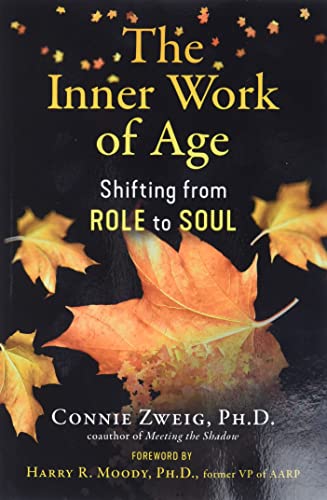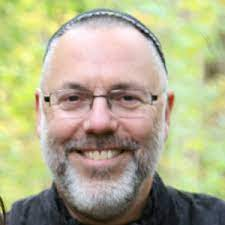[Editor’s note: Tikkun draws from the Jewish wisdom of the Torah, Talmud, Jewish mystical tradition, and draws selectively from the Zohar, and Hasidic tradition and from contemporary transformative political movements and brings to them a dimension that secular political movements ought to consider adding to their discourse. Rami Shapiro has much to teach secular activists. –Rabbi Michael Lerner]
The Inner Work of Age: An Interview with
Rabbi Rami Shapiro
By Connie Zweig, Ph.D.

In the award-winning book The Inner Work of Age: Shifting from Role to Soul, I extend my work on the Shadow into midlife and beyond and teach aging as a spiritual practice. As an author of several books about the Shadow, the personal unconscious, and as a therapist of thirty years, who teaches shadow-work, I always teach it in conjunction with meditation. And people often ask what one has to do with the other. How does the practice of exploring our unconscious, forbidden feelings and self-sabotaging actions relate to our spiritual lives?
The answer: In late life, if we are to allow into conscious awareness that which we most fear and dread—such as dependency, degeneration, and death—we need to be grounded in something larger than our personality, something beyond ego, which lies within each of us.
The term pure awareness refers to a state in which the mind, having gone beyond itself, is silent, open, resting, and simply aware of awareness. We might also call it transcendence, emptiness, sunyata, or turiya, which means pure consciousness in the Hindu tradition. Pure awareness is a portal to silence, which is already always there. Every mystical tradition has a name for it—and a Way to it. It’s the universal state of transcendence that the founder of every religion experienced. And it’s within each of us—between each thought, between each breath.
Pure awareness is not another object of awareness, like a thought or sensation. It’s the subject, the knower of all the objects. Whether we refer to it as emptiness or fullness, as Self or no-Self, it’s awareness itself or, as Ram Dass called it, loving awareness.
As we cultivate and dwell in the silence of pure awareness as a regular practice, a dispassionate inner observer, or witness, unfolds. We experience the witness as an objective inner spaciousness, a silent distance from the contents of our minds. When we feel overwhelmed by a shadow character and its loud, repetitive thought pattern, eventually, with the practice of pure awareness, we can simply witness that shadow, while sitting in our silent center.
Linda, a colleague, described it this way: “After raising three kids and completing a full-time career, I’m so grateful that I have time to just be. I can sit in this impersonal witness awareness, beyond the noise of my mind, and I’m fulfilled. I don’t need to try to fix anything anymore. I notice that the peace I exude is my influence on others. It affects everyone around me, and that’s enough now.”
As we age, we need to cultivate this awareness preventively, not when we’re in the midst of a physical or emotional crisis, grasping for solutions. We need to build a life raft now by cultivating a practice that brings us back to our center every day, not when the tidal wave is on the horizon.
Of course, that does not mean that a wave of health crises and losses won’t come; it does not mean that our grief will be any easier to bear. But it means that we will have more internal calm from which to relate to the crises that come into our lives. When we learn to silence the noise of the mind and to witness our fleeting thoughts, we can slowly break our identification with these thoughts. We may even glimpse something in us that does not change or age but is timeless.
People ask me, “Why sit still in these chaotic, dangerous times? Shouldn’t we be doing more, not closing our eyes? Shouldn’t we be paying attention to the news to stay informed? Shouldn’t we be marching in the streets?”
As more people grow irritated, outraged, and frightened by the world outside—the climate crisis, uprisings of racism and hate, global pandemics, and rampant misinformation—we need a daily refuge where we can recover and rejuvenate. We need more than ever a way to silence our noisy minds and go beyond our shadowy thoughts, in this way aligning with something deeper than the day’s headlines.
But meditation is not only for ourselves. Our inner and outer work are intimately connected. Our sitting practices prepare us to engage in social justice causes and serve the common good with less anger and more compassion, less projection and more sensitivity. Because we’re all interconnected, when we act from a silent center, we reduce the chaos and the noise, rather than add to it.
Many people have at least some basic experience with spiritual practices that give us a taste of what lies beyond ordinary, daily awareness. Some of us continue and deepen those practices; others let them go. But the tasks of late-life require the very traits and skills that meditation cultivates: a capacity not only to slow down but to slow downward, manage the mind, release the ego’s striving, be fully present, and attune to the voice of the soul.
Today, many of us experience the opposite state: We are drawn outward to the noise, increasingly agitated, angry, and saddened by the chaotic, violent events of our day. We are compelled to look and listen, and the result is that our bodies and minds are overloaded, feeling the disturbance in the Force. So, in this era, more than ever, we need to find a calm center, a refuge from the noise, a way to clear our minds and open our hearts. Over time, we will see the growing impact of turning our attention within.
There are many spiritual traditions, and each has its own exoteric moral/behavioral practices and esoteric inner/mystical practices, with its own method of turning attention inward. Some of us feel drawn to a particular tradition, say Judaism, Advaita, Buddhism, or Christianity. Others sample various traditions and practices through the decades, discovering the gifts and shadow issues of their many teachers and teachings. But the goal of all mystical or contemplative practice is universal: to quiet the mind until it rests in nondual pure awareness.
I spoke about spiritual practice in late life with Rabbi Rami Shapiro, 71, whose eclectic practices stem from mystical Judaism, Zen Buddhism, and Ramakrishna’s Hindu order. He has worked with Rabbi Zalman Schachter-Shalomi and Father Thomas Keating. Rami’s many books and workshops address the deep unifying experience of non-duality, or unity consciousness, in mystical traditions.
“My body reminds me of my age now,” Rami told me. “But the awakening to a singular reality feels ageless,” he said. “We can’t describe the indescribable, ineffable, infinite aspect, but it has no birth or death. If we experience that, even for a moment, everything changes. We’re no longer afraid of death because we know that we are just a wave returning to the ocean. The form is gone, Rami dies, but the oceanic essence remains the same.”
I asked him what he practices now, in this decade.
Rami: “Jewish mysticism suggests that we do one practice for each of the five dimensions of life. For the body, I do qigong. For the heart, I do metta compassion practice. For the mind, I study sacred texts and write about the links between psychology, religion, and spirituality. For the soul, I practice a mantra connected to the divine mother to become more aware of the interconnection of all things. And for the spirit, I practice self-inquiry from Ramana Maharshi, which involves exploring the many levels of the question Who am I?”
This sounded to me like a full-time job.
Rami: “Whatever we’re doing, our lives are always about exploring Who am I? For seekers, it’s always a relevant question. Even if they stop meditating for years, the question is there in the shadow. So, just pick it up again.”
Even in our later years? I asked.
Rami: “I find that the older I get, the more compelling the question becomes. At sixteen or sixty, ask the question in the same way, and it ripens into the same non-dual reality. Beneath the body of X number of years, the timeless essence remains.”
I asked him for some examples from his own experience. He spoke about sitting in a soundproof isolation tank, in zero gravity, when his body/mind disappeared into a nondual state.
Rami: “This Rami, these labels, these aches, and pains, are only the crest on the wave, not our true nature.”
Rami described having a similar experience when he sat with an Advaita, or Hindu nonduality, teacher. “I was talking away . . . when he asked, ‘Are you?’”
Rami continued: “Everything stopped. Time stopped. Gone. I returned a few minutes later, speechless and free. He had gone behind my mind to just the right question to silence it.”
**Adapted from The Inner Work of Age: Shifting from Role to Soul**
